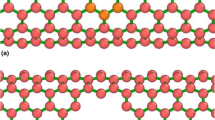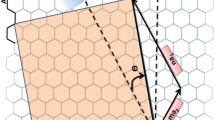Abstract
Context
Through experimental observations and reports, various challenges have been identified in carbon nanotubes (CNT), including Stone Wales (SW) flaws and position flaws. Among these imperfections, point vacancies are the most prevalent in the CNT lattice. However, there is currently no established method for detecting these issues, and the influence of these flaws on the vibrational properties of three-walled carbon nanotubes (TWCNTs) remains uncertain. This research paper introduces a novel approach that utilizes vibrational analysis to detect flaws in TWCNTs. By conducting the first investigation into the impact of point vacancies on the vibrational modal frequencies of TWCNTs, our study bridges these knowledge gaps.
Methods
This study examines the impact of defect quantity on various types of TWCNTs and investigates the vibrational properties of TWCNTs with point vacancies using a molecular structural mechanics technique. A total of 432 TWCNT models were simulated using molecular structural mechanics (MSM), and their modes were identified through finite element (FE) analysis. The fundamental vibration's natural frequency in TWCNTs with defects was then determined. The findings indicate that the depth of the mode shape is influenced by the TWCNTs' diameter, the extent of point vacancy defects, and the boundary condition. It was observed that as the number of vacancy defects increases from 0 to 4%, the natural frequency decreases. The study also establishes the order of TWCNTs with the highest natural vibrational frequency at 0%-point vacancy and \({10}^{-21} gm\) a given attached mass, which follows the sequence of chiral, armchair, and zigzag TWCNTs.














Similar content being viewed by others
References
Zhang S, Mielke SL, Khare R, Troya D, Ruoff RS, Schatz GC, Belytschko T (2005) Mechanics of defects in carbon nanotubes: atomistic and multiscale simulations. Phys Rev B 71:115403
Gibson RF, Ayorinde EO, Wen YF (2007) Vibrations of carbon nanotubes and their composites: a review. Compos Sci Technol 67(1):1–28
Iijima S, Ichihashi T (1993) Single-shell carbon nanotubes of 1-nm diameter. Nature 363(6430):603–605
Li C, Chou TW (2003) Single walled carbon nanotubes as ultrahigh frequency nanomechanical resonators. Phys Rev B. 68:73405–1-3
Li C, Chou TW (2003) Vibrational behaviors of multiwalled carbon nanotube based nanomechanical resonators. Appl Phys Lett 84:121–123
Hashemnia K, Farid M, Vatankhah R (2009) Vibrational analysis of carbon nanotubes and graphene sheets using molecular structural mechanics approach. Comput Mater Sci 47(1):79–85. https://doi.org/10.1016/j.commatsci.2009.06.016
Lee JH, Lee BS (2012) Modal analysis of carbon nanotubes and nanocones using FEM. Comput Mater Sci 51(1):30–42. https://doi.org/10.1016/j.commatsci.2011.06.041
Palacios JA, Ganesan R (2019) Dynamic response of single-walled carbon nanotubes based on various shell theories. J Reinf Plast Compos 38(9):413–425. https://doi.org/10.1177/0731684418824997
Wu CJ, Chou CY, Han CN, Chiang KN (2009) Estimation and validation of elastic modulus of carbon nanotubes using nano-scale tensile and vibrational analysis. Comput Model Eng Sci 41(1):49–67. https://doi.org/10.3970/cmes.2009.041.049
Singh S (2022) Determination of fundamental coupled torsional—radial frequency of single-walled carbon nanotubes. J Vib Control 28(5–6):677–688. https://doi.org/10.1177/1077546320981349
Zaporotskova IV, Boroznina NP, Parkhomenko YN, Kozhitov LV (2016) Carbon nan- otubes: sensor properties A review. Mod Electron Mater 2(4):95–105. https://doi.org/10.1016/j.moem.2017.02.002
Matsumoto N et al (2015) Elucidating the effect of heating induced structural change on electrical and thermal property improvement of single wall carbon nanotube. Carbon 87:239–245. https://doi.org/10.1016/j.carbon.2015.01.042. (N. Y.C)
Oluwalowo A, Nguyen N, Zhang S, Park JG, Liang R (2019) Electrical and thermal conductivity improvement of carbon nanotube and silver composites. Carbon 146:224–231. https://doi.org/10.1016/j.carbon.2019.01.073. (N. Y.)
Shoukat R, Khan MI (2021) Carbon nanotubes: a review on properties, synthesis methods and applications in micro and nanotechnology. Microsyst Technol 1–10. https://doi.org/10.1007/s00542-021-05211-6
Bourada F, Bousahla AA, Tounsi A, Bedia EAA, Mahmoud KH, Benra-Hou SR, Tounsi A (2020) Stability and dynamic analyses of SW-CNT reinforced concrete beam resting on elastic-foundation. Comput Concr 25(6):485–495. https://doi.org/10.12989/cac.2020.25.6.485
Bousahla AA et al (2020) Buckling and dynamic behavior of the simply supported CNT-RC beams using an integral-first shear deformation theory. Comput Concr 25(2):155–166. https://doi.org/10.12989/CAC.2020.25.2.155
Mohammadimehr M, Monajemi AA, Afshari H (2020) Free and forced vibration analysis of viscoelastic damped FG-CNT reinforced micro composite beams. Microsyst Technol 26(10):3085–3099. https://doi.org/10.1007/s00542-017-3682-4
Arani AG, Kiani F, Afshari H (2021) Free and forced vibration analysis of laminated functionally graded CNT-reinforced composite cylindrical panels. J Sandw Struct Mater 23(1):255–278. https://doi.org/10.1177/1099636219830787
Arani AG, Kiani F, Afshari H (2019) Aeroelastic analysis of laminated FG-CNTRC cylindrical panels under yawed supersonic flow. Int J Appl Mech 11(6):1950052. https://doi.org/10.1142/S1758825119500522
Al-Furjan MSH, Habibi M, Rahimi A, Chen G, Safarpour H, Safarpour M, Tounsi A (2020) Chaotic simulation of the multi-phase reinforced thermo-elastic disk using GDQM. Engineering with Computers 1–24. https://doi.org/10.1007/s00366-020-01144-2
Al-Furjan MSH, Habibi M, Jung DW, Sadeghi S, Safarpour H, Tounsi A, Chen G (2022) A computational framework for propagated waves in a sandwich doubly curved nanocomposite panel. Engineering with Computers 38(2):1679–1696. https://doi.org/10.1007/s00366-020-01130-8
Bendenia N et al (2020) Deflections, stresses and free vibration studies of FG-CNT reinforced sandwich plates resting on Pasternak elastic foundation. Comput Concr 26(3):213–226. https://doi.org/10.12989/cac.2020.26.3.213
Draoui A, Zidour M, Tounsi A, Adim B (2019) Static and dynamic behavior of nanotubes-reinforced sandwich plates using (FSDT). J Nano Res 57:117–135. https://doi.org/10.4028/www.scientific.net/JNanoR.57.117
Medani M et al (2019) Static and dynamic behavior of (FG-CNT) reinforced porous sandwich plate using energy principle. Steel Compos Struct 32(5):595–610. https://doi.org/10.12989/SCS.2019.32.5.595
Wang Q, Arash B (2014) A review on applications of carbon nanotubes and graphenes as nano-resonator sensors. Comput Mater Sci 82:350–360. https://doi.org/10.1016/j.commatsci.2013.10.010
Sireesha M, JagadeeshBabu V, Kranthi Kiran AS, Ramakrishna S (2018) A review on carbon nanotubes in biosensor devices and their applications in medicine. Nanocomposites 4(2):36–57. https://doi.org/10.1080/20550324.2018.1478765
Wang S, Wu F, Watanabe K, Taniguchi T, Zhou C, Wang F (2020) Metallic carbon nanotube nanocavities as ultracompact and low-loss fabry-perot plasmonic resonators. Nano Lett 20:2695–2702. https://doi.org/10.1021/acs.nanolett.0c00315
Wang R, Xie L, Hameed S, Wang C, Ying Y (2018) Mechanisms and applications of carbon nanotubes in terahertz devices: a review. Carbon 132:42–58. https://doi.org/10.1016/j.carbon.2018.02.005. (N. Y)
Bodily BH, Sun CT (2003) Structural and equivalent continuum properties of single-walled carbon nanotubes. Int J Mater Prod Technol 18:381–397
Sun X, Zhao W (2005) Prediction of stiffness and strength of single walled carbon nanotubes by molecular mechanics based finite element approach. Mater Sci Eng A 390:366–371
Belytschko T, Xiao SP, Schatz GC, Ruoff RS (2002) Atomistic simulations of nanotube fracture. Phys Rev B 65(23):235430
Mielke SL, Troya D, Zhang S et al (2004) The role of vacancy defects and holes in the fracture of carbon nanotubes. Chem Phys Lett 390:413–420
Hu YG, Liew KM, Wang Q, He XQ, Yakobson BI (2008) Nonlocal shell model for elastic wave propagation in single- and double-walled carbon nanotubes. J Mech Phys Solids 56:3475–3485
Chandra N, Namilae S, Shet C (2004) Local elastic properties of carbon nanotubes in the presence of stone-wales defects. Phys Rev B 69(9):094101
Xu KY, Guo XN, Ru CQ (2006) Vibration of a double-walled carbon nanotube aroused by nonlinear intertube van der Waals forces. J Appl Phys 99(1–7):064303
Fu YM, Hong JW, Wang XQ (2006) Analysis of nonlinear vibration for embedded carbon nanotubes. J Sound Vib 296:746–756
Wang Q, Varadan VK (2005) Wave characteristics of carbon nanotubes. Int J Solids Struct 43:254–265
Kiani K (2011) Application of nonlocal beam models to double-walled carbon nanotubes under a moving nanoparticle Part I: theoretical formulations. Acta Mech 216:197–206
Kiani K (2011) Application of nonlocal beam models to double-walled carbon nanotubes under a moving nanoparticle Part II: parametric study. Acta Mech 216:197–206
Bucior BJ et al (2017) Adsorption and diffusion of fluids in defective carbon nan- otubes: insights from molecular simulations. Langmuir 33(42):11834–11844. https://doi.org/10.1021/acs.langmuir.7b02841
Charlier JC (2002) Defects in carbon nanotubes. Acc Chem Res 35(12):1063–1069. https://doi.org/10.1021/ar010166k
Hudson RB, Sinha A (2018) An order reduction method for single-walled carbon nanotubes with multi-position defects. Carbon 138:81–89. https://doi.org/10.1016/j.carbon.2018.05.037
Hirai Y, Nishimaki S, Mori H, Kimoto Y, Akita S, Nakayama Y, Tanaka Y (2003) Molecular dynamics studies on mechanical properties of carbon nanotubes with pinhole defects. Jpn J Appl Phys 42:4120–4123
Xin H, Han Q, Yao X (2008) Buckling of defective single-walled and double-walled carbon nanotubes under axial compression by molecular dynamics simulation. Compos Sci Technol 68:1809–1814
Ebbesen TW, Takada T (1995) Wetting, filling and decorating carbon nanotubes. Carbon 33:937
Tserpes KI, Papanikos P (2007) The effect of Stone-Wales defect on the tensile behavior and fracture of single-walled carbon nanotubes. Compos Struct 79:581
Mielke SL, Troya D, Zhang S, Li J-L, Xiao S, Car R, Ruoff RS, Schatz GC, Belytschko T (2004) The role of vacancy defects and holes in the fracture of carbon nanotubes. Chem Phys Lett 390:413–420
Patel AM, Joshi AY (2013) Vibration Analysis of Double Wall Carbon Nanotube based Resonators for Zeptogram level Mass Recognition. Comput Mater Sci 79:230–238
Khademhosseini V, Dideban D, Ahmadi MT, Ismail R (2019) The impact of vacancy defects on the performance of a single-electron transistor with a car- bon nanotube island. J Comput Electron 18(2):428–435. https://doi.org/10.1007/s10825-018-01290-3
Yayli MÖ (2018) Torsional vibrations of restrained nanotubes using modified couple stress theory. Microsyst Technol 24(8):3425–3435. https://doi.org/10.1007/s00542-018-3735-3
Yayli MÖ (2018) An efficient solution method for the longitudinal vibration of nanorods with arbitrary boundary conditions via a hardening non- local approach. J Vib Control 24(11):2230–2246. https://doi.org/10.1177/1077546316684042
Yayli MÖ (2018) On the torsional vibrations of restrained nanotubes embedded in an elastic medium. J Braz Soc Mech Sci Eng 40(9):1–12. https://doi.org/10.1007/s40430-018-1346-7
Singh S, Dutt V (2020) A reduced form for fundamental transverse modal frequency of carbon nanotubes. Mater Today Commun 25:101404. https://doi.org/10.1016/j.mtcomm.2020.101404
Ardeshana B, Jani U, Patel A (2022 Oct) Influence of gradually vacating hexagonal patterns composition of CC bond in TWCNTs molecular structure using the FE method for vibrational analysis. Diam Relat Mater 1(128):109296
Ardeshana B, Jani U, Patel A (2022 Jun) Influence of Bending Angle on Mechanical Performance of SWCNTs and DWCNTs Based on Molecular Mechanics: FE Approach. J Vib Eng Technol 7:1–4
Patel AM, Ardeshana BA, Joshi AY (2017 Nov 10) Classifying the impact of progressively evacuating hexagonal lattices of CC bond in DWCNT-based nano resonators. Mater Technol 32(13):773–781
Ardeshana BA, Jani UB, Patel AM, Joshi AY (2021) Analyzing the dynamic characteristics of double‑walled carbon nanotube reinforced polymer nanocomposites. In: Handbook of polymer and ceramic nanotechnology. Springer International Publishing, Cham, pp 429–463
Ardeshana BA, Jani UB, Patel AM, Joshi AY (2018 Jun 7) Characterizing the vibration behavior of double walled carbon nano cones for sensing applications. Mater Technol 33(7):451–466
Ardeshana B, Jani U, Patel A, Joshi A (2017 Jan 1) An approach to modelling and simulation of single-walled carbon nanocones for sensing applications. AIMS Mater Sci 4(4):1010–1028
Funding
No funding was received to assist with the preparation of this manuscript.
Author information
Authors and Affiliations
Contributions
All authors contributed to the study conception and design. Material preparation, data collection and analysis were performed by [Bhavik Ardeshana, Umang Jani] and [Dr. Ajay M Patel]. The first draft of the manuscript was written by [Bhavik Ardeshana] and all authors commented on previous versions of the manuscript. All authors read and approved the final manuscript.
Corresponding author
Ethics declarations
Ethics approval
Not applicable.
Our manuscript does not report on or involve the use of any animal or human data or tissue.
Conflict of interest
The authors of this research work declare no conflict of interest.
Additional information
Publisher's note
Springer Nature remains neutral with regard to jurisdictional claims in published maps and institutional affiliations.
Rights and permissions
Springer Nature or its licensor (e.g. a society or other partner) holds exclusive rights to this article under a publishing agreement with the author(s) or other rightsholder(s); author self-archiving of the accepted manuscript version of this article is solely governed by the terms of such publishing agreement and applicable law.
About this article
Cite this article
Ardeshana, B., Jani, U. & Patel, A. Impact of point vacancy defects on vibrational behaviour of three-walled carbon nanotubes. J Mol Model 29, 214 (2023). https://doi.org/10.1007/s00894-023-05621-5
Received:
Accepted:
Published:
DOI: https://doi.org/10.1007/s00894-023-05621-5




